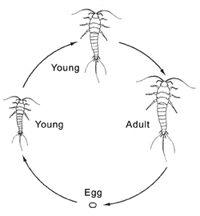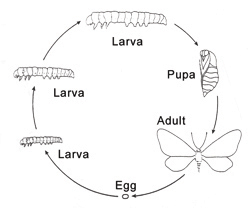|
With few exceptions, insects begin life as eggs. The change in form from eggs through to adults in insects is termed metamorphosis. Authorities use slight differences in metamorphosis to help describe and separate insect groups. For purposes of this publication, the most primitive insects
(Collembola and Thysanura) are said to develop without metamorphosis. The insect that comes from the egg appears exactly like the fully grown insect, except that it is not as large.
More advanced insects are described as having incomplete metamorphosis. Insects with incomplete metamorphosis change shape gradually as they grow. There are three stages of growth: the egg, nymph, and adult. Grasshoppers, termites, bugs, and lice are all of part of this group.
Insects with complete metamorphosis go through four stages of growth. None of the stages look at all like the others. These stages are referred to as egg, larva, pupa, and adult. Fleas, flies, beetles, bees, and moths all belong to this group.
|



